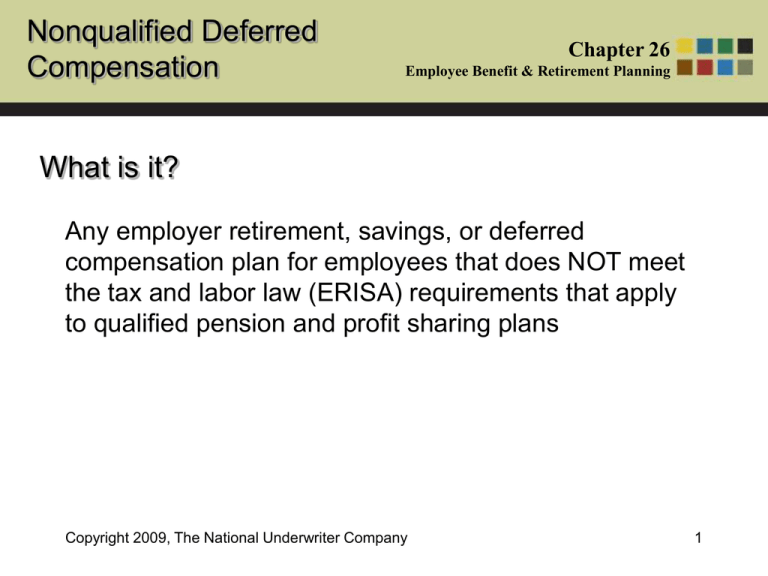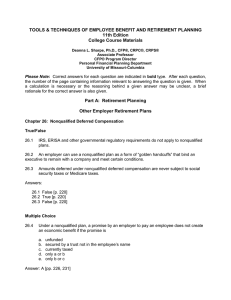Nonqualified Deferred Compensation What is it?
advertisement

Nonqualified Deferred Compensation Chapter 26 Employee Benefit & Retirement Planning What is it? Any employer retirement, savings, or deferred compensation plan for employees that does NOT meet the tax and labor law (ERISA) requirements that apply to qualified pension and profit sharing plans Copyright 2009, The National Underwriter Company 1 Nonqualified Deferred Compensation Chapter 26 Employee Benefit & Retirement Planning When is it indicated? To provide: – deferred compensation to executives and key employees only – additional deferred compensation to executives receiving maximum qualified plan benefits – deferred compensation to select key employees with different terms or conditions than others have Copyright 2009, The National Underwriter Company 2 Nonqualified Deferred Compensation Chapter 26 Employee Benefit & Retirement Planning When is it indicated? And when – executive or key employee wants to leverage employer tax savings for future benefits – employer needs to recruit, retain, reward, retire executive talent – closely-held corporation wants to attract and hold nonshareholder employees Copyright 2009, The National Underwriter Company 3 Nonqualified Deferred Compensation Chapter 26 Employee Benefit & Retirement Planning Advantages 1. flexible plan design 2. minimal IRS, ERISA, and other governmental regulatory requirements to meet 3. tax deferral for employees 4. marginal tax rates has favored corporate financing of deferred compensation in lieu of cash bonuses (but not at present) Copyright 2009, The National Underwriter Company 4 Nonqualified Deferred Compensation Chapter 26 Employee Benefit & Retirement Planning Advantages 5. employer can use as ‘golden handcuffs’ 6. use of informal financing arrangements (e.g. corporate owned life insurance) can provide employee with greater confidence of future payment than employer’s unsecured promise 7. assets set aside in some types of informal financing arrangements can still be used by corporation Copyright 2009, The National Underwriter Company 5 Nonqualified Deferred Compensation Chapter 26 Employee Benefit & Retirement Planning Disadvantages 1. Employer’s tax deduction deferred until income taxable to employee 2. plans often rest on employer’s unsecured promise to pay and do not have protection of tax and labor law 3. accounting treatment may reduce confidentiality of arrangement Copyright 2009, The National Underwriter Company 6 Nonqualified Deferred Compensation Chapter 26 Employee Benefit & Retirement Planning Disadvantages 4. some employers lack the structure necessary to successfully use nonqualified deferred compensation plans – – – S corporations businesses that may be short-lived tax exempt or government organizations Copyright 2009, The National Underwriter Company 7 Nonqualified Deferred Compensation Chapter 26 Employee Benefit & Retirement Planning Objectives in Plan Design Employer Objectives: – – – – – – – hire key employees retain key employees provide performance incentive control timing of and access to plan funds tax deferral benefit certainty have funds available during employment to extent possible under tax law Copyright 2009, The National Underwriter Company 8 Nonqualified Deferred Compensation Chapter 26 Employee Benefit & Retirement Planning Types of Benefit and Contribution Formulas Common Benefit Formulas – – – – salary continuation formula salary reduction formula excess benefit plan stock appreciation rights Copyright 2009, The National Underwriter Company 9 Nonqualified Deferred Compensation Chapter 26 Employee Benefit & Retirement Planning Types of Benefit and Contribution Formulas Form of Benefits – lump sum or series of annual payments at retirement – life annuities or joint and survivor annuities – must try to avoid ‘constructive receipt’ or benefits will be taxed before received – must try to avoid penalty for accelerated payments Copyright 2009, The National Underwriter Company 10 Nonqualified Deferred Compensation Chapter 26 Employee Benefit & Retirement Planning Withdrawals during employment Penalty free distributions for these events – – – – – – separation from service disability, usually strictly defined death of employee time specified under the plan change in business ownership or control unforeseeable emergency Copyright 2009, The National Underwriter Company 11 Nonqualified Deferred Compensation Chapter 26 Employee Benefit & Retirement Planning Withdrawals during employment “haircut” provision no longer allowed – allowed employee to withdraw amounts from plan without restriction except for small penalty – employee could ‘rescue’ funds from failing or hostile corporate environment – Congress now deems an abuse Copyright 2009, The National Underwriter Company 12 Nonqualified Deferred Compensation Chapter 26 Employee Benefit & Retirement Planning Termination of Employment Usually established in employer’s favor with benefits lost or reduced if terminate before retirement Can impose lengthy vesting schedule Often make special arrangements for disability Copyright 2009, The National Underwriter Company 13 Nonqualified Deferred Compensation Chapter 26 Employee Benefit & Retirement Planning Funded vs Unfunded Plans Funded plans a plan is formally funded if employer has set aside money or property to pay plan benefits through some means that restricts access to the fund by employer’s creditors – Subject to tax and ERISA regulations – Provides employee with greater confidence of future payment Copyright 2009, The National Underwriter Company 14 Nonqualified Deferred Compensation Chapter 26 Employee Benefit & Retirement Planning Funded vs Unfunded Plans Unfunded plans a plan is unfunded if the funds that the employer plans to use are accessible by employer's creditors – Avoids tax and ERISA regulations – Provides little security for employee Copyright 2009, The National Underwriter Company 15 Nonqualified Deferred Compensation Chapter 26 Employee Benefit & Retirement Planning Financing Approaches • reserve account maintained by employer • employer reserve account with employee investment direction • corporate owned life insurance • Rabbi trust • third party guarantees Copyright 2009, The National Underwriter Company 16 Nonqualified Deferred Compensation Chapter 26 Employee Benefit & Retirement Planning Tax Implications constructive receipt doctrine an amount is treated as received for tax purposes if ‘credited to employee account, set aside, or otherwise made available’ even if amount is not actually received economic benefit doctrine employee taxed when vested in contributions made to fund for employee even though employee cannot yet withdraw cash Copyright 2009, The National Underwriter Company 17 Nonqualified Deferred Compensation Chapter 26 Employee Benefit & Retirement Planning Income Taxation of Benefits and Contributions • employees pay ordinary income tax on benefits from unfunded nonqualified deferred compensation plans in the first year in which the benefit is actually or constructively received • death benefits payable to a beneficiary from nonqualified plans are taxable as income Copyright 2009, The National Underwriter Company 18 Nonqualified Deferred Compensation Chapter 26 Employee Benefit & Retirement Planning Social Security (FICA) Taxes • social security taxes payable when executive can no longer lose interest in plan • FICA taxes could become payable before year of actual receipt • social security taxable wage base has an upper limit but Medicare does not Copyright 2009, The National Underwriter Company 19 Nonqualified Deferred Compensation Chapter 26 Employee Benefit & Retirement Planning Federal Estate Tax Treatment • death benefit under nonqualified deferred compensation generally included in estate of deceased at its then present value • recipient can receive an income tax deduction • payments made to spouse may qualify for unlimited marital deduction, eliminating any federal estate tax Copyright 2009, The National Underwriter Company 20 Nonqualified Deferred Compensation Chapter 26 Employee Benefit & Retirement Planning Taxation of the Employer employer tax deduction delayed until compensation included in employee’s taxable income unfunded plans – year funds actively or constructively received formally funded plans – year employee becomes substantially vested Amounts deducted must be ‘reasonable’ Copyright 2009, The National Underwriter Company 21 Nonqualified Deferred Compensation Chapter 26 Employee Benefit & Retirement Planning ERISA Requirements Plans eligible for at least partial exemptions from ERISA requirements: – unfunded excess benefit plan – top-hat plan A plan that is not exempt must comply with most ERISA provisions for qualified plans including vesting, fiduciary, minimum funding, and reporting and disclosure Copyright 2009, The National Underwriter Company 22 Nonqualified Deferred Compensation Chapter 26 Employee Benefit & Retirement Planning True or False? 1. Both qualified and nonqualified deferred compensation plans allow an employee to defer income tax to a future time. 2. A nonqualified deferred compensation plan can be designed to cover any group of employees or one employee. 3. All organization except closely held businesses can use nonqualified deferred compensation for executive compensation. Copyright 2009, The National Underwriter Company 23 Nonqualified Deferred Compensation Chapter 26 Employee Benefit & Retirement Planning True or False? 4. A salary continuation plan requires no reduction in the covered employee’s salary. 5. Excess benefit plans are subject to Title 1 of ERISA. 6. Tom Jenkens, an executive at X Corp, withdrew funds from his nonqualified deferred compensation plan after an accident left him totally and permanently disabled. Tom will have to pay a penalty for this withdrawal. Copyright 2009, The National Underwriter Company 24 Nonqualified Deferred Compensation Chapter 26 Employee Benefit & Retirement Planning True or False? 7. An employer’s creditors can access monies in a funded nonqualified deferred compensation plan. 8. A reserve account maintained by the employer increases benefit security for the employee. 9. John became vested in his nonqualified deferred compensation plan this year, but will not receive the funds until retirement. John must pay Social Security taxes this year. 10. All nonqualified plans are exempt from ERISA Copyright 2009, The National Underwriter Company 25 Nonqualified Deferred Compensation Chapter 26 Employee Benefit & Retirement Planning Discussion Question When using a rabbi trust, what costs or risk are involved? What provisions should or should not be included? Copyright 2009, The National Underwriter Company 26

